Traditions and Memes
If you compare notes with your friends, you’ll probably discover that the holiday traditions your family practiced while you were growing up, and that you continue as an adult, differ in some ways that defy explanation. Maybe your family opened gifts on Christmas Eve and then slept in on December 25. Perhaps you had to wait at the top of the stairs on Christmas morning while your parents arranged things around the tree. But regardless of those details, if you grew up in the Western Hemisphere, your holidays were surely influenced by a meme: sugar plums.
You’re familiar with memes – those silly images or videos that get passed around the internet. But I’m thinking of them in a different context.
A meme is an idea, behavior, or style that spreads by means of imitation from person to person within a culture and often carries symbolic meaning representing a particular phenomenon or theme.
And while we assume that sugar plums are real things, how many of us have actually seen, let alone tasted, one? Are they really real?
For this week’s post, I’m going to provide some proof. Not about Santa Claus, Virginia. Just about sugar plums.
A Quick Trip Down Memory Lane – Remembering Our Origin Story
We launched The Cook and The Writer in August, 2018. It was the result of a brief discussion that Mary and I had one day. Something like this:
Mike: I’m looking for a good writing project.
Mary: How about we start a food and travel blog?
Mike: Great idea. How hard can that be?
(For now, we’ll set aside the obvious naivete of my question or my complete inability to grasp the scope of a complex topic. I’ve lost count of how many times I’ve asked that question, and I’m sorry to say that the lessons I’ve learned have never stuck with me.)
Almost as quickly as we made the decision to start the blog, we selected Mimi Sheraton’s book “1,000 Foods to Eat Before You Die” as our Guidebook. This was a far better decision, because it gave us a source of ideas that led us to try some things we might never had tried, like Hakka salt-baked chicken and rose petal jelly. It also gave us extra inspiration to seek out new foods and experiences while traveling. During a trip to Italy and Sicily in 2019, we tore a section out of the book and took it with us to help us focus on the unique foods in the area.
Stalking the Wild Sugar Plum
Earlier this year, after we arrived in Portugal, we looked through the Guidebook to see what Mimi had to say about Portuguese food. It was a short section – only three Portuguese dishes were mentioned – and they were combined with some others under the heading “Spanish and Portuguese”. That’s a combination that some of our new neighbors might take issue with. Wars have been fought, etc.
One of the dishes that Mimi highlighted was sugar plums. I made a note – “write about this in December” – and here we are. When you start asking “what are sugar plums?”, you find some interesting, and contradictory answers. Here’s what I learned.
Sugar Plums – History and Mythology
The children were nestled all snug in their beds,
While visions of sugar-plums danced in their heads…
Those familiar lines from Clement Clarke Moore’s poem “A Visit from St. Nicholas”, a.k.a. “The Night Before Christmas” are almost obligatory in any discussion of sugar plums. Let’s face it – they represent one of only two reference points most of us have. The other is the Sugar Plum Fairy in Tchaikovsky’s Nutcracker Suite.
Sometimes they really are plums
The greengage plum is grown across western Europe and is known by several names, including Reine Claude in France, in honor of Queen Claude (1499-1524). In Portugal they are similarly known as Raínha Cláudia.
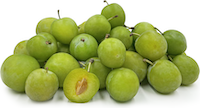
In the 16th or 17th century, Dominican nuns in the town of Elvas created a delicacy using Raínha Cláudia plums. They boiled them in a sugary syrup, then preserved them whole in the syrup or dried them and coated them with sugar. The sugared plums were served with another local dessert, called sericaia, made with eggs, sugar, milk, cinnamon, and flour.
Plums soaked in sugar sounds like what something called a “sugar plum” might be. Unfortunately, greengages are not in season now, so I couldn’t find any in the local stores.
Zingerman’s, the Michigan deli and food store, sells candied greengage plums from Portugal that have been soaked in sugar syrup for six weeks, then dried in the sun. They’re pricey – $40 USD for 9 plums – but they’re also out of stock right now.
Two Alternative Views
I found two other explanations for “what is a sugar plum?”.
Let’s start with Mimi Sheraton’s description:
Originally created in Portugal as bombos de figo (fig bombes, or rounds) and first recorded in the sixteenth or seventeenth century, these brightly wrapped sweets … are formed of dried figs or prunes… Slowly steamed to luscious, syrupy softness, the dried fruit is ground and seasoned with cinnamon, cloves, and red wine or brandy, then formed into balls with a roasted almond pressed into the center. Finally, they are rolled in white sugar and wrapped in bright, colorful paper.
From “1,000 Foods to Eat Before You Die”, pg. 272
In an aside, Mimi also mentioned that in England, sugarplums are also known as comfits, which are made from fruits, nuts, or seeds coated and preserved with sugar.
Fun fact: You probably think you’ve never heard of comfits before, but you simply forgot. In Alice’s Adventures in Wonderland, Alice has a box of comfits in her pocket, which she hands out as prizes after the Caucus Race. (That’s where the participants ran in patterns of any shape, starting and leaving off whenever they liked, so that everyone wins.)

“At last the Dodo said, ‘Everybody has won, and all must have prizes.’
But who is to give the prizes?’ quite a chorus of voices asked.
‘Why, she, of course,’ said the Dodo, pointing to Alice with one finger; and the whole party at once crowded round her, calling out in a confused way, ‘Prizes! Prizes!’
Alice had no idea what to do, and in despair she put her hand in her pocket, and pulled out a box of comfits, (luckily the salt water had not got into it), and handed them round as prizes. There was exactly one a-piece all round.
Lewis Carroll, Alice’s Adventures in Wonderland (1865)
I found a more scholarly point of view from Samira Kawash, a Ph. D. and professor emerita at Rutgers University. She is the author of Candy; A Century of Panic and Pleasure and founder of the website Candy Professor. Writing in the Atlantic Monthly, Professor Kawash provided a contrasting opinion:
The truth of the matter is that the sugar plum is not a plum at all, nor does it contain any plum-like substance. The sugar plums of Christmas fantasy are in fact sugar, and any resemblance to plums is entirely superficial.
She also gave a more detailed explanation of comfit, describing it as “a sweet made of sugar hardened around a central seed or kernel in successive layers.” Some modern day examples of comfit are jawbreakers, jelly beans and M&Ms.
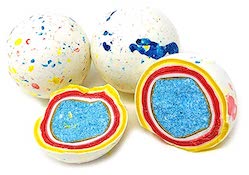
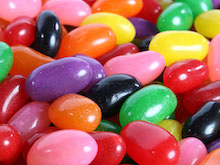
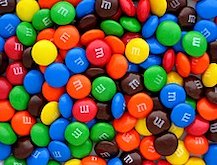
So Who’s Right?
I’m always fascinated when I research a topic like this and find multiple stories that contain similarities and contradictions. But since I’m not a historian, I’ll leave the task of reconciling the differences to others. What I wanted was to taste a sugar plum.
Since I couldn’t buy one locally, I decided to make some. The recipe I found seemed to respect both of the histories – it included fruit, nuts, and spices – and it was simple enough that even a writer could follow it. (Though I had some careful supervision by our resident cook!)
Here’s the recipe.
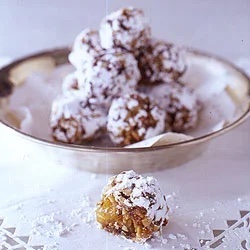
Sugar Plums
Source: David Sawyer on Saveur.com
Yield: Makes 75
David’s Comments
“… while visions of sugarplums danced in their heads.” The famous sugar plums spoken about in Clement Clark Moore’s beloved poem, “‘Twas the Night Before Christmas” were actually sugar-coated coriander. Later the recipe changed and included other spices and dried fruit. This recipe is based on the confection we know today. Sugar plums tend to absorb the powdered sugar, so redust just before eating, if you like.
Ingredients
- 2 cups whole almonds
- 1⁄4 cup honey
- 2 tsp. grated orange zest
- 1 1⁄2 tsp. ground cinnamon
- 1⁄2 tsp. ground allspice
- 1⁄2 tsp. freshly grated nutmeg
- 1 cup finely chopped dried apricots
- 1 cup finely chopped pitted dates
- 1 cup confectioners’ sugar
Preparation
Preheat oven to 400°. Arrange almonds on a baking sheet in a single layer and toast in oven for 10 minutes. Set aside to cool, then finely chop.
Meanwhile, combine honey, orange zest, cinnamon, allspice, and nutmeg in a medium mixing bowl. Add almonds, apricots, and dates and mix well.
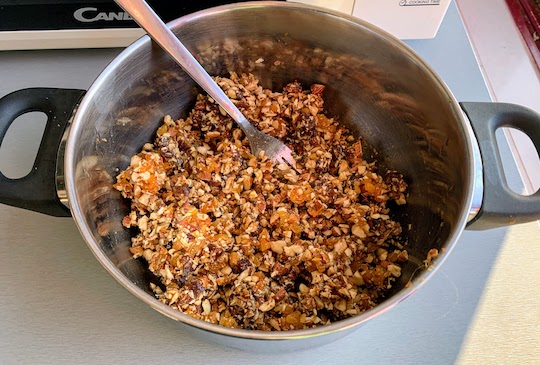
Pinch off rounded teaspoon-size pieces of the mixture and roll into balls. (Rinse your hands often, as mixture is very sticky.) Roll balls in sugar, then refrigerate in single layers between sheets of waxed paper in airtight containers for up to 1 month. Their flavor improves after ripening for several days.
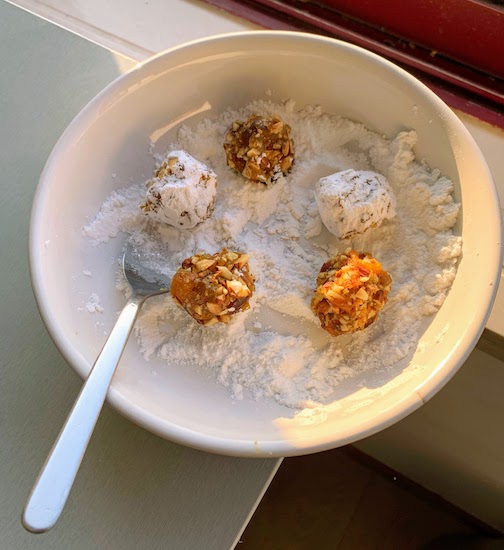
Mike’s Notes
I made a half batch. You can have too much of a good thing. Mine were bigger, so the yield was about 28.
It took me about an hour to make these, mostly because I had to chop everything by hand. If you have a food processor, it will go much faster.
Mary showed me a great kitchen hack to make working with the sticky ingredients easier. She put a bowl of water next to the bowl of mixed ingredients. Before making a ball, I could dip my hand in the water. The fruit and nut mixture wouldn’t stick to my wet hand.
Conclusion
These are very sweet, but the flavors – fruit, nuts, spices, even the orange from the zest – all come through. And they’re great with coffee!
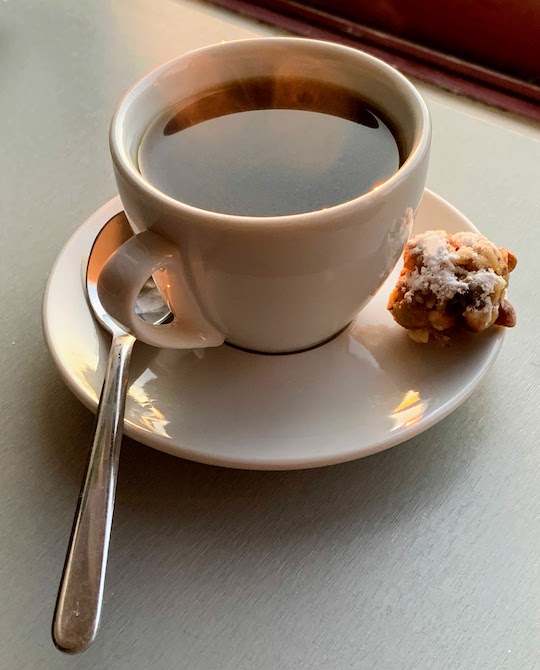
Now that you know about the history of sugar plums and have a recipe to make them, I hope you can make your own “visions of sugar plums” become a reality.
I’ll end on a serious note today. Much of what we write here is about food. But there are millions of people in the world who face severe hunger or starvation. Please take a moment to read our other new post, A Serious Note, and join us in taking small steps toward eliminating hunger around the world.
Thanks for reading and taking action / Obrigado por ler e agir
Mike
The Writer
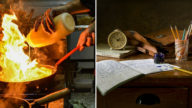

I love this week’s entry as both a writer and as a cook. You tackled complicated constructs in both respects and they turned out beautifully! Quite an achievement!
Hugs,
Nan
Thanks, Nan. Sometimes writing these things is like pulling teeth. This one was much easier to put together. I appreciate your feedback.
All the best,
Mike